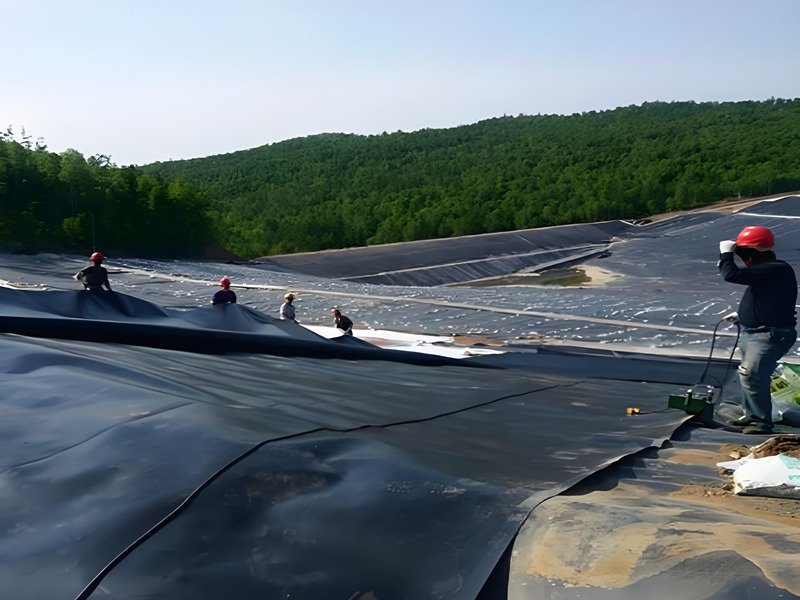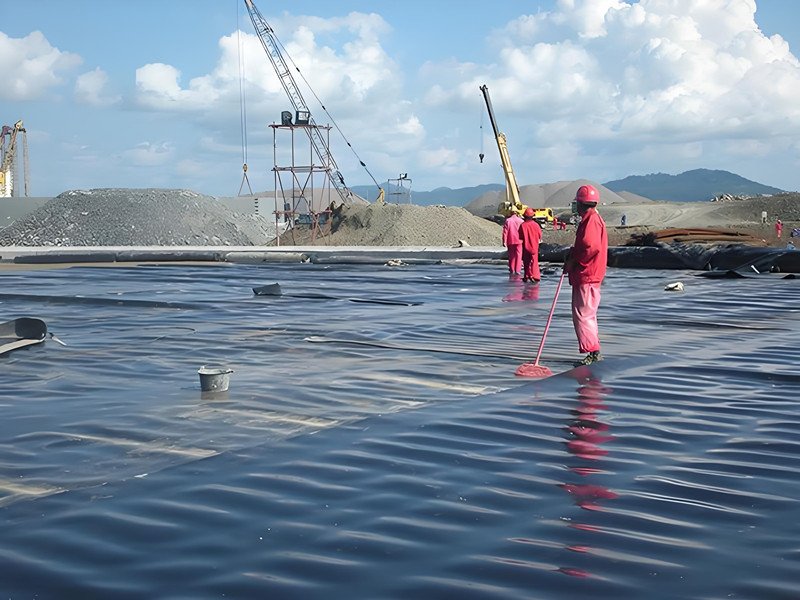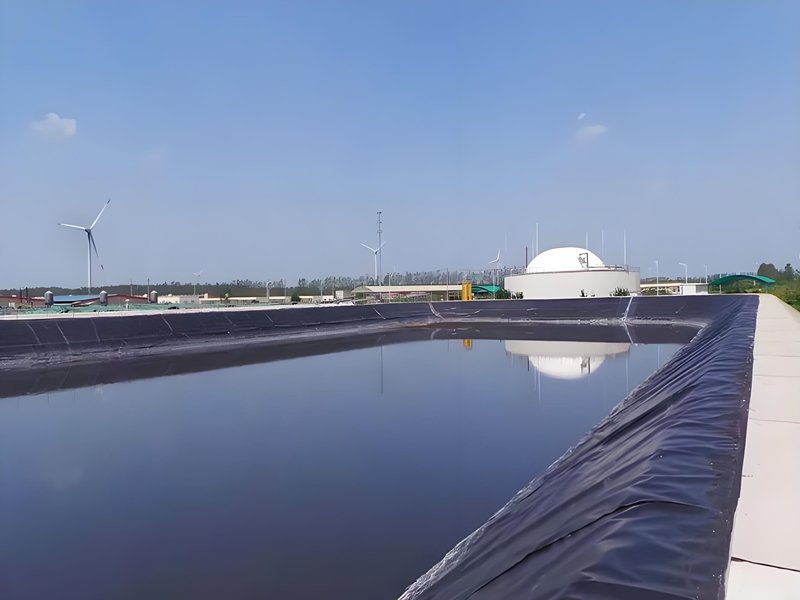A geomembrane liner, also known as geomembrane,is a synthetic membrane used to prevent the leakage or seepage of fluids, gases, or contaminants. It is a flexible or semi-rigid sheet made of materials like HDPE, LDPE, PVC, or EPDM. Geomembrane liners are widely used in environmental, civil engineering, and industrial projects. They act as barriers in applications such as landfills, wastewater treatment facilities, mining operations, agricultural ponds, and secondary containment areas. BPM Geomembrane offer advantages like chemical resistance, tensile strength, and durability. Quality control measures ensure their effectiveness, and regular inspection and maintenance are essential. Overall, geomembrane liners play a crucial role in containment and protection, promoting environmental sustainability and safe fluid management.
1. What Is Geomembrane Liner?
A geomembrane liner is a flexible or semi-rigid sheet made from materials like HDPE, LDPE, PVC, or other specialized polymers. It is used as a synthetic barrier in a wide range of applications to prevent the passage of fluids, gases, and contaminants. Geomembrane liners find extensive use in environmental, civil engineering, and geotechnical projects. They are installed as protective layers to contain or isolate liquids, gases, or solids, thereby preventing pollution, seepage, and the spread of contaminants.
Geomembrane liners are designed to offer chemical resistance, durability, and flexibility, enabling them to withstand harsh environmental conditions, including UV exposure, temperature fluctuations, and mechanical stresses. Quality control measures, such as thickness, strength, and integrity testing, are implemented during manufacturing and installation to ensure the liner’s reliability. Overall, geomembrane liners play a crucial role in preventing the movement of fluids, gases, or contaminants, thereby protecting the environment and promoting effective containment.


2.What Are Advantages of Geomembrane Liner?
Geomembrane liners offer several advantages in various applications. Here are some key advantages of using geomembrane liners:
2.1 Secure Containment and Leak Prevention
Geomembrane liners act as reliable barriers, effectively preventing the passage of fluids, gases, or contaminants. They ensure that substances remain contained within their designated areas, eliminating the risk of leakage or seepage that could harm the environment or contaminate water sources.
2.2 Exceptional Chemical Resistance
Geomembrane liners exhibit remarkable resistance to a wide array of chemicals, including acids, alkalis, and organic solvents. This resistance enables them to maintain their integrity even when exposed to potentially corrosive substances, making them highly suitable for applications in industries such as mining, agriculture, and wastewater treatment.
2.3 Long-lasting Durability
Geomembrane liners are designed to be exceptionally durable, providing a prolonged service life. They can withstand challenging environmental conditions, including UV radiation, temperature fluctuations, and mechanical stresses. This durability ensures the liner’s performance and effectiveness over an extended period, reducing the need for frequent replacements or repairs.
2.4 Flexibility and Adaptability
Geomembrane liners come in various thicknesses and can be fabricated to meet the specific requirements of different projects. They possess flexibility, allowing them to conform to irregular surfaces and accommodate movements or settlement in the underlying soil. This adaptability makes them versatile and well-suited for a wide range of applications.
2.5 Environmental Preservation
By serving as effective barriers, geomembrane liners play a crucial role in safeguarding the environment from contamination and pollution. They prevent the migration of harmful substances into the soil, water bodies, or groundwater, ensuring the preservation of ecosystems and the protection of human health.
2.6 Efficient Installation
Geomembrane liners can be installed with high efficiency, resulting in reduced project timelines and labor costs. They can be pre-fabricated under controlled factory conditions, ensuring consistent quality and minimizing on-site installation time.
3. What Is Geomembrane Liner Use For?
Geomembrane liners are used for a wide range of applications due to their ability to provide effective containment and protection. Here are some common uses of geomembrane liners:
3.1 Waste Management
Geomembrane liners are extensively utilized in waste management systems, particularly in landfills, to prevent the escape or seepage of waste materials into the surrounding environment. They act as impermeable barriers, ensuring that potentially harmful substances remain contained within the landfill, minimizing the risk of environmental contamination.
3.2 Water Storage and Conservation
Geomembrane liners are employed to line ponds, reservoirs, and water storage facilities. They create impermeable barriers that prevent seepage, ensuring efficient water storage and conservation. These liners are crucial for agricultural irrigation, aquaculture, and maintaining water supplies.
3.3 Mining and Leachate Control
In mining operations, geomembrane liners are utilized to contain minerals, chemicals, and leachate within heap leach pads, tailings ponds, and storage areas. They help prevent the escape of these substances, protecting the surrounding environment from potential contamination and preserving water resources.
3.4 Agriculture and Aquaculture Management
Geomembrane liners play a significant role in agriculture, such as lining irrigation canals, agricultural ponds, and waste containment systems. They aid in efficient water management, preventing soil erosion and the leaching of fertilizers and pesticides. In aquaculture, these liners are used for fish or shrimp ponds to maintain water levels and prevent seepage.
3.5 Civil Engineering and Construction
Geomembrane liners find application in various civil engineering and construction projects. They are used for canal lining to prevent water loss, slope stabilization to prevent erosion, and as a waterproofing layer in structures such as tunnels, basements, and retaining walls.
3.6 Environmental Remediation
Geomembrane liners are utilized in environmental remediation projects, where contaminated soils or industrial waste areas need to be contained and treated. They isolate and control the spread of pollutants, protecting the surrounding environment during remediation activities.


4.How Much Does A Geomembrane Liner Cost?
The cost of a geomembrane liner can vary depending on several factors, including the type of material, thickness, size of the project, installation requirements, and market conditions. Here are some general considerations regarding the cost of geomembrane liners:
4.1 Material Type
Geomembrane liners are available in different materials such as HDPE (High-Density Polyethylene), LDPE (Low-Density Polyethylene), PVC (Polyvinyl Chloride), and other specialized polymers. The cost can vary based on the material’s availability, manufacturing process, and performance characteristics.
4.2 Thickness
Geomembrane liners come in various thicknesses, typically ranging from 0.5mm to 3mm or more. Thicker liners generally cost more due to the increased material required.
4.3 Project Size
The size of the project, including the area to be lined and the volume of liner material needed, can impact the overall cost. Larger projects may benefit from economies of scale, potentially reducing the cost per square meter or square foot.
4.4 Installation Requirements
The complexity of the installation process, such as site preparation, subgrade preparation, anchoring systems, and specialized equipment, can affect the overall cost. Projects with challenging terrain or specific installation techniques may incur additional expenses.
4.5 Market Conditions
Market fluctuations, including raw material costs, transportation costs, and supply and demand dynamics, can influence the price of geomembrane liners. Prices may vary over time due to market factors.
4.6 Lifetime Cost
The lifecycle cost is not significant, but it is sometimes overlooked.The average lifespan should also be considered before placing an order. Geomembranes with a successful performance record of over 30 years may have higher initial costs, but the return on investment will be higher than those with lower initial costs and can only be used for 5 to 15 years. Which one would you choose?
5. Summary
Geomembranes are increasingly popular in many projects, such as fish ponds, dams, water treatment, landfills, mining, root barriers, biogas, etc. However, some clients may not understand the cost of Geomembranes and may not know how to choose the appropriate Geomembrane for their projects.The cost of a geomembrane liner can differ greatly based on factors like the type of material, thickness, project size, installation requirements, and market conditions. Providing an exact cost without specific project details is challenging. To obtain accurate cost estimates, it is advisable to consult with suppliers or contractors who specialize in geomembrane liners. They can assess the project’s unique requirements, taking into account factors such as the desired material, thickness, size, and installation needs.
Of course you can contact us, we will analyze your project from a professional perspective and provide you with a one-stop solution.We can also manufacture to your special requirements, and can also provide ODM, OEM and customized services.If you have any questions, please contact us.





